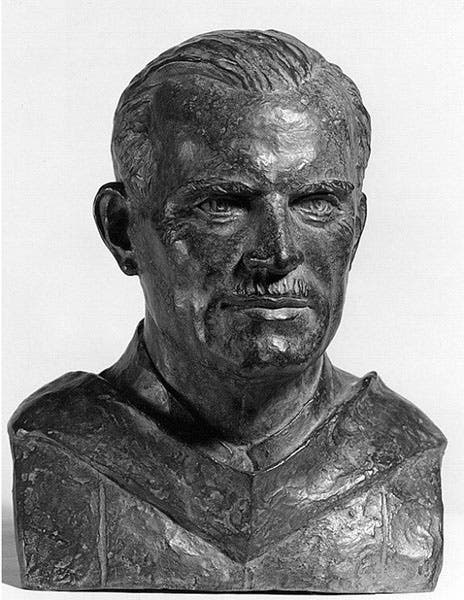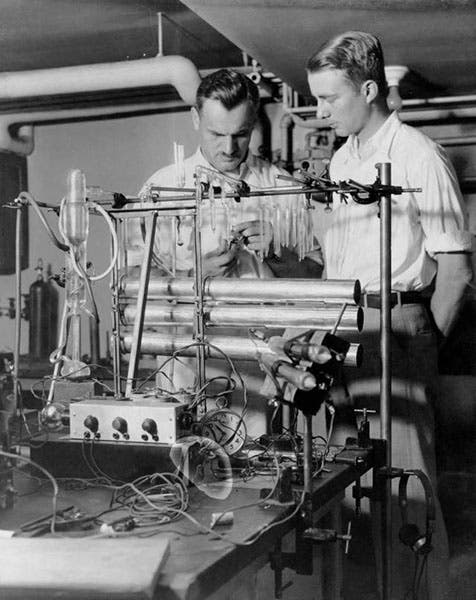Scientist of the Day - Arthur Holly Compton
The first issue of Time Magazine was published on Mar. 3, 1923, and it featured Joseph Cannon, an Illinois politician, on the cover. Thus began a tradition of featuring one person on each cover, which after 1927, sat within the now familiar red border. The Time covers that first year portrayed politicians, statesmen, businessmen, and writers, but no scientists. Nor did a scientist grace the cover in 1924, 1925, 1926, 1927, and almost not in 1928, until on the very last day of that year, the Time cover featured Henry Fairfield Osborn of the American Museum of Natural History. Almost 300 issues had hit the streets before that historic first scientist cover. Less than two months later, Albert Einstein was the cover person (Feb. 18, 1929), and then we had to wait until 1934 for James B. Conant, and 1935, for Harlow Shapley. All of these, except Einstein, were Americans. Scientists one might expect to be worthy of cover honors, such as Niels Bohr, Werner Heisenberg, Paul Dirac, or Wolfgang Pauli, never appeared on the cover of Time.
On Jan. 13, 1936, Time published its fifth issue with a scientist on the cover (first image). That man was our Scientist of the Day, Arthur Holly Compton. Compton was born on Sep. 20, 1892, in Ohio, the youngest of three brothers, all of whom would earn PhD's from Princeton and all of whom would be president or chancellor of a major university at some point in their careers, which I would guess is a rare family occurrence. Arthur was a physicist and managed to win a post-doctoral fellowship to the Cavendish Lab at Cambridge, England, where he met and worked with Rutherford, C. T. R Wilson, and George Thompson, the son of the pioneer in atomic physics, J. J. Thompson.
Compton studied X-ray scattering – what happens when you bounce X-rays off things like electrons. He discovered, to his surprise, that often the scattered X-rays had longer wave-lengths that the incident waves, which in classical physics, could not happen. The effect (which came to be called the Compton effect) could only be explained if X-rays travelled in packets, or quanta, the energy of which depended on wave-length. Albert Einstein had proposed in 1905 that visible light is quantized – the first confirmation of Max Planck’s quantum theory. Compton extended quantum theory to include other forms of electro-magnetic radiation, such as X-rays. So impressive were his experimental results that Louis de Broglie, inspired by Compton, proposed the next year that not only do waves have particle-like properties, but particles such as electrons have wave-like properties, which allowed him to explain the discrete energy levels of the atom. Two years later, Erwin Schrödinger wrote a wave equation for the hydrogen atom, and quantum mechanics had arrived. Compton’s discovery was essential, and for it, he won the Nobel Prize in physics in 1927, sharing it with C.T.R. Wilson.
But Time in 1936 was not honoring Compton for the Compton effect. When Compton returned from Cambridge, he took up a position at the University of Chicago, and by 1930, he was investigating cosmic rays. Robert Millikan at Caltech had initiated cosmic ray studies in the United States, and his student Carl Anderson, examining cosmic ray interactions, discovered the positron, the first known example of anti-matter, in 1932. But Millikan thought that cosmic rays consisted of gamma-rays and X-rays, not particles. Compton discovered that cosmic rays are actually energetic particles – protons, electrons, alpha particles – that collide with atoms in the outer atmosphere and produce the X-rays and gamma rays that we detect on Earth. It was this discovery that won Compton his place on the cover of Time.
During the Second World War, Compton was head of what was code-named the Metallurgical Laboratory, in charge of large-scale production of uranium 235 and plutonium for the Manhattan Project. He was also included in one of the great photographs of scientific war-time America, taken in March of 1940, which included E. O. Lawrence, Vannevar Bush, James B. Conant, Arthur’s brother Karl Compton, and Alfred Loomis (fifth image). Arthur is the second from the left. Conant, surprisingly, was on four different Time covers during his career, beating out Einstein. We showed them all in our post on Conant.
After the end of the War, Compton moved to St. Louis to become Chancellor of Washington University (oldest brother Karl was president of MIT at the time, and older brother Wilson was president of Washington State University). A few years ago, while in St. Louis, I was strolling the city’s Walk of Fame and was delighted to find the star of blues guitarist Albert King, and then surprised and delighted to find that the star right next to it was that of Arthur Holly Compton (sixth image). It looked quite at home there, with the likes of Josephine Baker and Charles Lindbergh.
Dr. William B. Ashworth, Jr., Consultant for the History of Science, Linda Hall Library and Associate Professor emeritus, Department of History, University of Missouri-Kansas City. Comments or corrections are welcome; please direct to ashworthw@umkc.edu.









![Using an astrolabe to measure the depth of a well, woodcut in Elucidatio fabricae vsusq[ue] astrolabii, by Johannes Stöffler, 1513 (Linda Hall Library)](https://assets-us-01.kc-usercontent.com:443/9dd25524-761a-000d-d79f-86a5086d4774/a998eb50-55d2-4a88-ace2-a50aa5fa86e7/Stoffler%201.jpg?w=210&h=210&auto=format&fit=crop)

